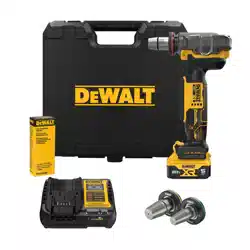Loading ...
Loading ...
Loading ...

9
English
Installing and Removing the Expander
Head (Fig.A, E)
iMPORTAnT: To reduce the chance of damage to
your PEXexpander, always store your tool with the
expanderhead
2
installed.
1. To install an expander head
2
screw onto the tool
clockwise until hand tight. DO nOT over tighten.
2. To uninstall an expander head, unscrew from the
toolcounterclockwise.
Hang Hook (Fig.A, F)
WARNING: To reduce the risk of serious personal
injury, ONLY use the tool's hang hook to hang the
tool from a work belt. DO NOT use the hang hook
for tethering or securing the tool to a person or object
during use. DO NOT suspend tool overhead or suspend
objects from the hanghook.
WARNING: To reduce the risk of serious personal
injury, ensure the screws holding the hang hook aresecure.
CAUTION: To reduce the risk of personal injury or
damage, DO NOT use the hang hook to hang the
expander tool while using as aspotlight.
iMPORTAnT: When attaching or replacing the
hanghook
7
, use only the screws
11
that are provided. Be
sure to securely tighten thescrews
11
.
The hang hook
7
can be be attached to either side of the
tool using only the screws
11
provided, to accommodate
left- or right- handed users.
nOTE: If the hang hook is not desired at all, it can be
removed from thetool.
1. To move the hang hook
7
, remove the screws
11
that
hold the hang hook
7
in place. Install removed screws
and securely tighten thescrews
11
.
2. Remove the screws
11
on the desired side of the tool
and reassemble the hang hook
7
. Be sure to securely
tighten thescrews.
ASSEMBLY AND ADJUSTMENTS
WARNING:
To reduce the risk of serious personal
injury, turn unit off and
remove the battery pack
before making any adjustments or removing/
installing attachments or accessories. An accidental
start‑up can causeinjury.
Wall Mounting
Some DeWALT chargers are designed to be wall mountable
or to sit upright on a table or work surface.If wall mounting,
switches to the pack charging mode. This feature ensures
maximum battery packlife.
A cold battery pack may charge at a slower rate than a warm
batterypack.
The hot/cold pack delay will be indicated by the red light(s)
continuing to blink but with the yellow light continuously
ON. Once the battery pack has reached an appropriate
temperature, the yellow light will turn OFF and the charger
will resume the chargingprocedure.
DCB118 and DCB1112 Chargers
The DCB118 and DCB1112 chargers are equipped with
an internal fan designed to cool the battery pack. The fan
will turn on automatically when the battery pack needs to
becooled.
Never operate the charger if the fan does not operate
properly or if ventilation slots are blocked. Do not permit
foreign objects to enter the interior of thecharger.
Electronic Protection system
Li-ion tools are designed with an Electronic Protection
System that will protect the battery pack against overloading,
overheating or deep discharge. The tool will automatically
turn off and the battery pack will need to berecharged.
Important Charging Notes
1. Longest life and best performance can be obtained if
the battery pack is charged when the air temperature
is between 65° F – 75° F (18° C– 24° C). DO NOT charge
when the battery pack is below 40° F (4.5° C), or above
104° F (40° C). This is important and will prevent serious
damage to the batterypack.
2. The charger and battery pack may become warm to the
touch while charging. This is a normal condition, and
does not indicate a problem. To facilitate the cooling of
the battery pack after use, avoid placing the charger or
battery pack in a warm environment such as in a metal
shed or an uninsulatedtrailer.
3. If the battery pack does not charge properly:
a. Check operation of receptacle by plugging in a lamp
or other appliance;
b. Check to see if receptacle is connected to a light
switch which turns power off when you turn out
thelights;
c. If charging problems persist, take the tool, battery
pack and charger to your local servicecenter.
4. You may charge a partially used pack whenever you
desire with no adverse effect on the batterypack.
Charger Cleaning Instructions
WARNING:Shock hazard. Disconnectthe charger
from the AC outlet before cleaning. Dirt and grease
may be removed from the exterior of the charger using
a cloth or soft non‑metallic brush. Do not use water or
any cleaningsolutions.
locate the charger within reach of an electrical outlet, and
away from a corner or other obstructions which may impede
air flow. Use the back of the charger as a template for the
location of the mounting screws on the wall. Mount the
charger securely using drywall screws (purchased separately)
at least 1” (25.4mm) long, with a screw head diameter of
0.28–0.35” (7–9mm), screwed into wood to an optimal
depth leaving approximately 7/32” (5.5 mm) of the screw
exposed. Align the slots on the back of the charger with the
exposed screws and fully engage them in theslots.
SAVE THESE INSTRUCTIONS FOR
FUTURE USE
Loading ...
Loading ...
Loading ...
